Wet Re-entry and Roll with a Paddle Float
If you would like an alternative to the standard paddle float recovery (See USK Article "Solo Paddle Float Recovery"), which necessitates you climbing out of the water onto the kayak, then consider learning this skill. It takes a good deal of energy to get onto your kayak, especially when you are wearing a lot of clothing. The higher the your kayak deck is out of the water, the harder you have to work to climb onto it. Over the years I have realized it is a lot easier to get into your kayak while you are in the water and your kayak is upside down. Of course this means putting your head back underwater. If you use nose clips the discomfort is eliminated. Then you just have to work on your submersion attitude.
The skill is not a difficult one with respect to coordination. It is more a mental skill than a coordination skill. You don't have to be able to roll to do this, just know the basic movement. The lift provided by the paddle float makes this a doable skill for non-rollers.
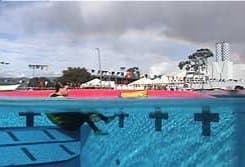
We begin our skill after you have wet exited and have decided which re-entry method you will use. Put the paddle float onto your paddle and blow it up if inflatable. Foam floats cut down your immersion time. Inflatable floats generally have more floatation than foam floats.
If you keep one leg in your cockpit you can have two hands free while you inflate your paddle float and attach it to the end of your paddle. I use the leg in the cockpit often so I can have both hands free and still maintain contact with my kayak. However, I do not recommend keeping your leg in the cockpit in tidal streams, surf zones or rock gardens.
When ready, do a wet re-entry keeping the paddle float towards the bow. Learning how to hold the paddle shaft and cockpit coaming takes a few practice tries. Doing a wet re-entry is best done by putting your feet in first while holding your kayak on edge. You are still keeping your head above water during this part of the maneuver. You only need to put your head underwater when you are ready to slide your backside into the cockpit.
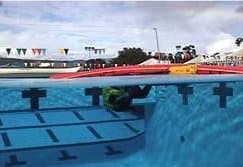
You can also keep the paddle shaft between your body and arm if you cannot hold onto the shaft and the coaming at the same time. Regardless of how you deal with the paddle, you will be grabbing the coaming with both hands to get yourself securely into your cockpit. One hand on one side of the coaming and the other hand on the opposite side. The hand that is farthest away from the paddle will eventually become the leading hand.
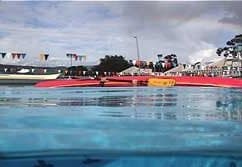
Once you are in your seat with feet on the foot braces and knees under the thigh braces, grab the paddle with two hands. If you were able to hold the shaft and coaming, then all you need to do is grab the paddle shaft with your other hand. This hand will be the leading hand.
If you had the paddle floating between your arm and body, you will have to look for the paddle with both hands. Once the paddle is in both hands, push both hands toward the sky. This set-up allows the paddle to sweep out without having the uncovered blade get stuck next to the kayak.
After reaching for the sky with your paddle, (keep your paddle parallel to the surface of the water) sweep the float end out to the side keeping the paddle perpendicular over your kayak. The uncovered blade will be over the bottom of you kayak as you sweep out.
In order to right your kayak, do a hip snap as you use your paddle with float as support. The hip snap is actually a leg action, which rights your kayak. (See USK article, "Hip Snap.") Whichever hand is closest to the paddle float, use the corresponding thigh to pull the kayak upright, by pulling up against the thigh brace (right hand, right thigh).
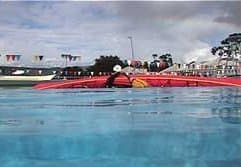
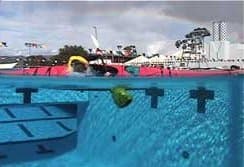
When you sweep the paddle out to the side it is important not to sweep past 90-degrees. The 90-degree position gives you the most support and leverage. If you go beyond 90-degrees, you not only lose leverage you run a risk of shoulder injury and possible re-capsize as you will see later in the article.
How much your paddle float goes underwater is dependent upon a number of factors which include: actual flotation of float, weight of paddler, technique of paddler and distance the float is from the kayak. You get more support if the float is farther from the kayak. Extending your paddle out from the kayak can give you more lift. However, don't put it out too far because you can loose your lever depending upon your technique.
Think of this motion as a kayak righting motion, NOT a pulling down on the paddle motion. If you concentrate on pulling down you may neglect to focus on righting your kayak with your lower body. It is best to focus on rolling your kayak up and just trust your paddle with float will provide the support you need.
Once up, pump out the water. The conditions will dictate if you need to have your skirt on the coaming or not. If water is getting into the cockpit due waves breaking over your deck, then you should attach the spray skirt.
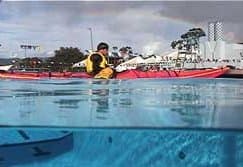
This is a good time to take a momentary break to collect yourself. You can rest on your paddle float as long as you keep the paddle shaft perpendicular to the kayak. The key is to keep your balance point toward the float. A real capsize leaves most paddlers a little off their game. If you are alone use you paddle with float for support. If you have others nearby, have one or two of them come over to raft up until you are ready top proceed. You may need to adjust clothing depending on the conditions (See USK article, "Seaworthy.").
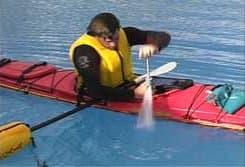
If you rest your forearm on paddle shaft and hold the pump with the same hand you will be tilting the kayak towards the paddle float, which allows the water to pool by the pump. That same hand can hold the pump and skirt if need be. The free hand does the pumping. If the pumping arm gets tired you can switch hands, but you will need to swing the paddle around so the float is on the other side of the kayak. On rough days it is imperative you have a stable support while you pump out the water.
As with the traditional paddle float recovery, the most unstable part of the recovery is deflating and replacing the float to where you normally keep it stored. I find I have greater balance if I relax my hips and watch the horizon. If I let the kayak move as needed with the water and not tense my body I feel stable.
This recovery technique is not as difficult as it appears. As long as you can get into your kayak while it is underwater (5-10 seconds of breath holding) you should be able to learn this skill. The advantage to using this skill is not having to climb up on your deck. My wife prefers getting into the kayak this way rather than expending the energy of climbing up on her back deck.
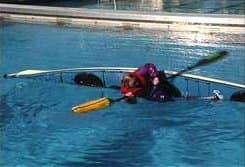
Hadley's first attempt at doing this skill was not smooth. She looked like she muscled herself up. She cannot roll a kayak and has never taken a rolling class. As long as she keeps the paddle shaft over her kayak with the float out to the side she has enough support to right herself.
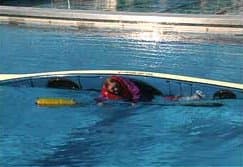
Remember to keep the paddle shaft over the kayak. If the paddle shaft slides off of the kayak you will loose you lever. This usually happens if the float is swept too far behind you.
If that were to happen, first try to reposition the paddle over the kayak as long as you have not slipped out of the seat. If you have slipped out of the seat start the skill again remembering NOT to sweep the paddle beyond 90-degrees.
Again, the purpose of this solo recovery is to reduce the amount of work the paddler exerts getting back into their kayak. Once upright in the kayak water still needs to get pumped out regardless of which variation you choose to use. One of the advantages in this variation is the paddler is in the ready to pump position when they come up. It is a very secure position.
Since the year 2000, I have been using this variation as the main solo recovery when I teach recovery/rescue classes. I have found the key is using nose clips during the wet re-entry, because it is a planned immersion. If the water is cold a neoprene hood is also very helpful. I teach this skill as a three step sequence. Step one, get in kayak. Step two, position paddle out to the side. Step three, right yourself.
I recommend you try the skill if you don't like climbing on to the deck of your kayak.
Pictures seen above were taken from the USK video Capsize Recoveries & Rescue Procedures
Wayne Horodowich, founder of The University of Sea Kayaking (USK), writes monthly articles for the USK web site. In addition, Wayne has produced the popular "In Depth" Instructional Video Series for Sea Kayaking.
Related Articles
Last month we discussed how to detect and patch (not "repair") a leak on a typical roto-molded kayak…
A kayaker should have a number of recovery methods to choose from in their bag of skills. I feel the…
There are two ways of swimming through a rapid. You can swim defensively or offensively. Defensive…
Watch this short tutorial video on the Continuous Greenland Roll with useful underwater shots and a…


